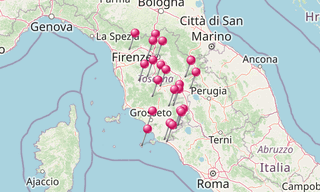Arezzo is a city in Central Italy, located in Tuscany. Arezzo is about 80 km south-east of Florence, at an elevation of 296 m above sea level. Arezzo is set on a steep hill rising from the floodplain of the Arno River. In the upper part of the town are the cathedral, the town hall and the Medici Fortress (Fortezza Medicea), from which the main streets branch off towards the lower part as far as the gates.
Main sights
- Piazza Grande: Medieval square, once the main marketplace of the city, it is currently the site of the Giostra del Saracino (“Joust of the Saracen”).
- Palace of the Lay Fraternity (Fraternita dei Laici): 14th - 15th century palazzo, with a Gothic ground floor and a quattrocento second floor by Bernardo Rossellino.
- Vasari Loggia along the north side, a flat Mannerist façade designed by Giorgio Vasari.
- Episcopal Palace: Seat of the bishops, rebuilt in the mid-13th century. The interior has frescoes by Salvi Castellucci, Teofilo Torri, and Pietro Benvenuti.
- Palazzo Cofani-Brizzolari: with the Torre Faggiolana.
- Church of Santa Maria della Pieve: The church was built in the 12th century over a pre-existing Palaeo-Christian edifice, and renovated a century later with the addition of the characteristic façade made of loggias with small arches surmounted by all different-styled columns.
- Cathedral of Saint Donatus: The interior has a nave and aisles divided by massive pilasters. The left aisle has a fresco by Piero della Francesca portraying the Madeleine. Noteworthy are also the medieval stained glass, the Tarlati Chapel (1334) and the Gothic tomb of Pope Gregory X.
- Basilica of San Francesco: The interior has a single nave: the main attraction is the History of the True Cross fresco (1453 - 1464) cycle by Piero della Francesca in the Bacci Chapel.
- Basilica of San Domenico (founded in 1275 and completed in the early 14th century): The interior has a single nave with a Crucifix by Cimabue, a masterwork of 13th century Italian art.
- Santa Maria in Gradi: A medieval church from the 11th or the 12th century, but rebuilt in the late 16th century by Bartolomeo Ammannati.
- Church of St Augustine: founded in 1257, modified in the late 15th and the late 18th centuries.
- Badia di SS. Flora e Lucilla: Built by Benedictine monks in the 12th century, it was totally restored in the 16th century under the direction of Giorgio Vasari.
- Church of San Lorenzo: Built before the year 1000, most likely in Palaeo-Christian times.
- Church of Santa Maria delle Grazie: A late Gothic sanctuary with a Renaissance portal by Benedetto da Maiano (1490).
- Church of Santissima Trinita. Built in 1348, it was totally renovated in 1723 - 1748 in Baroque style.
- Church of Santa Maria Maddalena Built in 1561 over a pre-14th century structure. It houses a Madonna with Child (Madonna of the Rose) by Spinello Aretino.

-Santi-Pietro-e-Donato-(Duomo).hero.landscape.jpg?w=1600)

-Santi-Pietro-e-Donato-(Duomo).jpg?w=256)
-Santi-Pietro-e-Donato-(Duomo).jpg?w=256)
-Santa-Maria-della-Pieve.jpg?w=256)
-Santi-Pietro-e-Donato-(Duomo).jpg?w=256)
-Santi-Pietro-e-Donato-(Duomo).jpg?w=256)
.jpg?w=256)
.jpg?w=256)
.jpg?w=256)
-Santi-Pietro-e-Donato-(Duomo).jpg?w=256)
.jpg?w=256)
-Santi-Pietro-e-Donato-(Duomo).jpg?w=256)
-Santi-Pietro-e-Donato-(Duomo).jpg?w=256)
-Santi-Pietro-e-Donato-(Duomo).jpg?w=256)
.jpg?w=256)
-Santi-Pietro-e-Donato-(Duomo).jpg?w=256)
-Santi-Pietro-e-Donato-(Duomo).jpg?w=256)
.jpg?w=256)
.jpg?w=256)
.jpg?w=256)
-Santi-Pietro-e-Donato-(Duomo).jpg?w=256)
-Santi-Pietro-e-Donato-(Duomo).jpg?w=256)
.jpg?w=256)
.jpg?w=256)
.jpg?w=256)
-Santi-Pietro-e-Donato-(Duomo).jpg?w=256)
.jpg?w=256)
-Santi-Pietro-e-Donato-(Duomo).jpg?w=256)
.jpg?w=256)
.jpg?w=256)
-Cattedrale-di-Santa-Maria-del-Fiore.hero.jpg?w=320)
